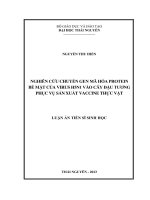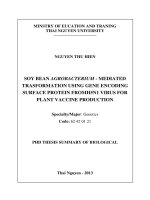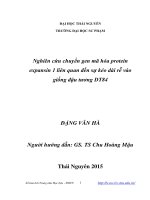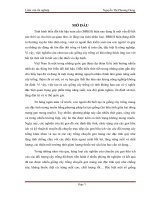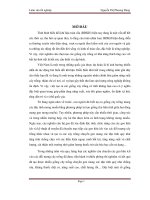nghiên cứu chuyển gen mã hóa protein bề mặt của virus h5n1 vào cây đậu tương phục vụ sản xuất vaccine thực vậ bản tóm tắt tiếng anh
Bạn đang xem bản rút gọn của tài liệu. Xem và tải ngay bản đầy đủ của tài liệu tại đây (618.38 KB, 27 trang )
MINSTRY OF EUCATION AND TRANING
THAI NGUYEN UNIVERSITY
––––––––––––––––––––
NGUYEN THU HIEN
SOY BEAN AGROBACTERIUM - MEDIATED
TRASFORMATION USING GENE ENCODING
SURFACE PROTEIN FROMH5N1 VIRUS FOR
PLANT VACCINE PRODUCTION
Specialty/Major: Genetics
Code: 62 42 01 21
PHD THESIS SUMMARY OF BIOLOGICAL
Thai Nguyen - 2013
The work was completed at:
Technology Division plant cells, Institute of Biotechnology
Department of Biology-Genetics modern, Department of Biology - Audit
College of education - Thai Nguyen University.
Objection 1:
Objection 2:
Supervisor: 1. Assoc. Prof. Chu Hoang Ha (PhD)
2. Prof. Dr. Chu Hoang Mau (PhD)
1
INTRODUCTION
1. Background
Flu is the most common transmitted disease and can be fatal.
Annually, there are about half of billion people suffered from the
disease. Currently, A/H5N1 flu virus, the most dangerous avian
virus, has been spread over forty countries in Asia, Middle East,
Europe and Africa. In Vietnam, H5N1 Avian pandemic has been
outbreak late 2003 resulted in avian industries and also human health.
Therefore, it has been necessary for scientists to carry out research to
learn about the pathogenic pathway, epidemic mechanism so the
pandemic can be prevented and controlled.
Edible vaccine is made from plant and can stimulate both
humoral and cell-medicated immune systems. It is similar to other
common vaccines, but produced by plants and contained in plant’s
part such as leaves, roots, seeds, and fruits. There are several
advantages of plant vaccine such as low cost, easy to manufacture,
highly efficiency, and safe for use. Therefore, plant vaccine is being
considered suitable for public health strategies in developing
countries. In Vietnam, soybean is one of the main sources in food
supply for both human and animals. From that points of view, the
project titled “Soy Bean Agrobacterium-Mediated Transformation
Using Gene Encoding Surface Proteins from H5N1 Virus for Plant
Vaccine Production” has been carried out.
2
2. General aims
The general purpose of this thesis project is to engineer a
genetic transformed soy bean genotype, expressing surface protein
from A/H5N1 virus, which can be used for producing edible vaccine.
In details, two specific aims of the project were
- To design and recombine genetic carrier vectors containing
HA gen and HA1 gen region from virus A/H5N1;
- To regenerate a HA1 genetic transformed soy bean cultivar
with recombined HA1 protein expression in seeds.
3. Specific aims:
- Design and synthesis transgenic vectors carrying HA gen and
HA1 region.
- Induced these genes into Agrobacterium tumefaciens and to
confirm that genes were delivered a tobacco genotype was
infected with recombined A. tumefaciens and then
regenerated the tobacco carrying HA gene, HA1 gen region.
- Developed and optimized a protocol to generate the
formation of multiple adventitious shoots using cotyledonary
node explants from young seedlings. Evaluated the efficiency
transformation of gus gen in DT12 and DT84 soybean
genotypes.
- Transferred the HA1 gen vector to the soybean genotypes
using A. tumefacien-mediated transformation system, and
3
determined the transient expression and regeneration rate of
HA1 gene in T0 generation.
- Analyzed HA1 gene expression of T1 transformed soybean
lines using PCR and Western blot.
4. Results
- HA gen and HA1 gen region vectors have been successfully
synthesized and recombined into A. tumefaciens.
- Transient infection efficiencies and regeneration rates of gus
gen in DT12 and Dt84 soybean genotypes were 7.8% and
4.3%, respectively.
- Eight T0 transgenic plant lines have been archived and
expressed specific vector SLHEP-HA1 in seeds.
- T0 transgenic plants produced positive T1 seedlings with
HA1op gen and HA1 protein expression in seeds. This
transformed soybean genotype was named H11
5. Relevance and future direction
Scientifics: gene HA and Ha1 gene region have been created and
expressed in plants. The protocol for gen transformation of these
genes using A. tumefaciens has been developed and applied.
In practice: The successful in engineering a HA1 genetic
transformed soybean H11 genotype opens an opportunity for
producing a soybean product that contains HA1 antigen. This product
4
can be used for avian breeding and its protein may act as plant
vaccine to prevent the avian flu pandemic in the future.
We suggest to continue screening for the stable transformation
efficiencies of the transformed soybean genotypes in the next
generation and to examine the immune respond of the animals that
bred with the transgenic plant.
6. Thesis format
There are 110 pages in this thesis that consists of Introduction (4
pages); Chapter 1: literature review (43 pages); Chapter 2: materials
and methods ((14 pages); Chapter 3: results and discussion ( 43
pages); Conclusion (2 pages). The thesis consists of 36 figures and 16
tables and referred 156 references.
Chapter 1
LITERATURE REVIEW
The thesis referred 23 Vietnamese and 133 English references
which cover the related topics such as (1) Varian flu and A/H5N1
virus, (2) A/H5N1 flu vaccine, (3) the application of gen
transformation in plant vaccine manufacturing.
Avian flu is an acute transmitted disease caused by flu virus type
A Orthomyxoviridae. This viral type is classified into sub-types
based on their capsid surface antigen HA and NA. there are 16 HA
sub-types (H1 – H16), and 9 NA sub-types (N 1 – N9). In principle,
the combination of HA and NA sub-types will generate many more
5
new sub-types. Gen structure of A/H5N1 includes 8 separate regions
and there is no gen encoding RNA repairing enzyme. The region 4
encodes surface protein which is specific for each A flu virus. This
protein (hemaglutinin - HA) is an antigen and plays an important role
in viral lethal. It can stimulate the host body to generate specific
cytokines for each viral type to neutralise virus and prevent them
from infecting the body again. This is the principle for manufacturing
vaccines.
For human flu, the research and development of vaccine for
poultry will not only prevent their disease spread out but also control
the risk of the flu transmitting into human.
There are several A/H5N1 flu vaccines such as traditional
vaccines and new generation of vaccines using gen technology,
synthesis vaccines, and edible vaccines. In Vietnam, HA gen
expression in tobacco plant has been successfully reported, and there
are works on progress in expression of this gene into other plants
such as soybean. Also there has been many researches carried out,
there is no plant vaccine manufactured for clinical use so far. Even
though, developing plant vaccine models for both human and animal
is a very promising pathway to prevent and control infectious
transmitted diseases in Vietnam.
6
Chapter 2
MATERIALS AND METHODS
2.1. Materials
Plans:
Soybean genotypes DT12 and DT84 were supplied by Centre for
legume research and development, Institute of cereal plants, National
Academy of Agriculture.
Bacteria and vectors
- pPTN289 vector and pDest-phaso were supplied by VUB.
- HA gene from A/H5N1 virus was provided by Institute for
biotechnology.
- E.coli and A.tumefaciens CV58 and EHA101 was from plant
cell technology laboratory –Institute for Biotechnology.
Chemicals and instruments used in this project provided by plant
cell technology laboratory and central gen technology laboratory,
institute for biotechnology.
2.2. Methods
2.2.1. Methods and techniques used to generate gen transformed
vectors
- PCR
- Gel electrophoresis
7
- Inducing reaction: inducing into E. coli following published
heat shock method (Cohen 1972).
- Selection using PCR and selected enzyme method according to
methods of Sambroook el al. (2001).
- Gen transformed vector generated using Gateway technique.
- Inducing recombined vectors into A. tumefaciens
2.2.2. In vitro regeneration and transformation models
- Method for regeneration of tobacco
- Method for regeneration of soybean based on the method of
Olhoft et al (2001) using cotyledonary nodes from the mature seeds.
2.2.3. Analysis of transformed plants
- PCR: DNA from transformed plant genotypes were extracted
according to Edwards et al. (1991)
- Proteins were extracted from seeds with 12.5% gel SDS
polyacrylamide (Laemmli 1970).
- Western blot: total protein from SDS gel were transferred to
nitrocellulose Hybond membrane (Amershame). Hybrid membrane
then washed by TBS and blocked using 3% BSA for 1 hour. And
then second wash and incubated with c-myc in TBS supplemented
with 0.5% BSA and 0.05% tween for 1 hour. The membrane was
washed again and incubated with Ig 2 with ALP or rat IgG
inconbination with horseradish peroxidise (HRP – Abcam). After the
8
last wash the membrane were incubated with NBT/BCIP or using
EDL kit (Amersham) to determine the recombined proteins
Chapter 3
RESULTS AND DISCUSSION
3.1. Transformed vectors with HA gen and HA1 gen region of
H5N1 virus
3.1.1 Gen HA in the transformed vector
The immune cells do not recognise the whole antigen
molecules. They only identify certain part of the antigens called
epitope. There have been reported that the epitopes B and T of the
HA gen of H3N1 virus are in the region 91-108 and 307-319,
respectively. The HA sequence of A/H5N1 (AJ8670074) indicates a
similar amino acide sequences of the above epitope. The vectors
express in the plants containing SLHEP structure with a peptide
signal (2S2), B and T epitopes from HA, which can stimulate an
immune on the intestine, the sequence to recognise endo-proteins
(KDEL) and enzymes.
3.1.1.1. Generation for HA gen containing triple codes highly
express in plants
Recombined protein expression is the foundation of the
modern biotechnology. However, it is great challenge to express
proteins of one to another species. Some can be greatly expressed in
one plant but not in the other. The aim of this project was to express
9
the HA gen from H5N1 virus into plants. Therefore, some triple
coded gens have been modified to amplify the HA gen expression in
the host cells. Based on the HA gen sequence and HA protein, we
have been able to recombine a new HA gen (HAop) which has high
level of expression in the plant. This recombined gen constructed of
1695 nucleotides and although the triple helix codes have been
modified, there was no change in acid amino sequence.
3.1.1.2 Designing recombined vector carrying HAop gen
HAop gen sequence was used to recombine a primmer. It has
been checked on 0.8% agarose gel with 1kb standard DNA ladder
(fig. 3.3) and found that the DNA of 1.7kb. This size was similar to
our calculation.
Figure 3.3: PCR results of HAop gen using XhoI-HA/Hind III-HA
(M: standard DNA ladder 1kb)
10
Insert HA gen region into p201-SLHEP vector
The gen product was cut by enzymes XhoI/HindIII and inserted
into p201-SLHEP vector between attL1 and attL2 region. The vector
also carries antibiotic resistant gen Kanamycin so we can select the
right plasmid during selection process. At the end of the process
recombined plasmid p201-SLHEP-HA generated.
Selection of recombined plasmid using restricted enzyme
To ensure that HA gen has been inserted in the vector, the
plasmid has been cut by enzyme XhoI/HindIII. In theory, when the
plasmid cut by 2 restricted enzymes it will be resulted in two DNAs:
inserted gen (1.7kb) and vector (2.5kb). They were determined using
0.8% agarose gel (fig. 3.7)
Figure 3. 7. Electrophoresis image of selection of recombined
plasmid p201-SLHEP-HA
Our results from agarose gel indicated that all of the three types
showed that all of the DNA bands have the same expected size. It
means HA gen region has been inserted successfully into the vector.
2,5kb
1,7kb
11
This recombined vector was the material for Gateway transformed
method.
3.1.1.3. Generation of vector carrying HAop expressing in seed.
HAop gen and gens encoding functioning peptides were
transformed in to pPhaso-dest vector by LR reaction (Gateway
system). Re-examination of recombined vector using specific primer
XhoI-HA/HindIII-HA showed gen with the size of 1.7kb. While
using restricted enzyme EcoRI resulted in 3 DNAs size 2.2kb, 5kb,
and 10lb. They were similar with what we have calculated. (Fig. 3.9).
the first one has been selected for induced into bacterium A.
tumefaciens.
Figure 3.9: recombined vector pPhaso-HAop A. A: PCR method,
B: restricted enzyme; M: standard ladder 1kb; 1, 2, 3: vector.
12
3.1.1.4. Generation of a. tumefaciens
The recombined vector has been induced into a. tumefaciens by
electrical pulse method. PCR examination as showed in fig. 3.10
confirmed that the pPhaso-HAop vector has been successfully
transferred into the bacterium.
Figure 3.10. Electrophoresis of pPhaso-HAop vetctor induced in
a. tumefaciens CV58.
3.1.2 Generation of transformed vector containing HA1 gen
region
HA gen region is relatively large (1.7kb), and it epitope B and T
located at 91 – 108 and 307 – 319 at the beginning end of the HA.
Therefore, we selected a HA gen region with the size about 0.5kb
smaller than whole HA gen. This region named HAlop. To insert
this region into the vector p201-SLEHP, we used XhoI-HA1 and
HindIII-HA1 primers to amplify HA1 gens. The end of HA1 contain
codes for restricted enzymes XhoI and HindIII.
13
3.1.2.1. HAlop gen transformation
HA1 gen isolation, amplification, and encoding
We use 50ng DNA recombined plasmid carrying HA gen in PCR to
amplify HA1 using the specific primers. The results show in fig. 3.13
Figure 3. 13. electrophoresis of HA1
The length of this DNA was 1.25kb which is the same size as
HA1. The amplification also generated materials for selection
process. The encoding process was carried out using ABI – 313-
DNA capillary electrophoresis system.
Inserting HA1 into p201-SLHEP vector
The process is similar to the process of inserting HA gen
described above. We were then induced the vector into E. coli. Then
examined the results using restricted enzymes and then start selection
process.
14
Recombined plasmid selection using restricted enzyme
The results of this process were two DNA sized 1.25kb and 2.5kb
(fig. 3.15)
Figure 3.15: Electrophoresis of recombined plasmid p201-
SLHEP_HA1
Gateway method for transforming HA1 into transformed vector
And to selct the desired types we have determined the products
using colony-PCr reaction and restricted enzymes.
The results of Colony – PCR in fig. 3.16 confirmed that all 5
randomised colony lines presented DNA bands with the expected
size of 1.25kb. Meaning the HA1 was transformed into E. coli HD5
alpha.
15
Figure 3.16: electrophoresis of transformed vector with pPhaso-
SLHEP-HA1. Upper line: PRC using XhoI-HA1/HindIII-HA1;
lower line: cut using HindIII
Induction of pPhaso-SLHEP-HA1 into agrobacterium
50 – 100ng plasmid pPhaso-SLHEP – HA1 transformed into A.
tumefaciens. They were incubated at 280C in antibiotic selected
medium for 2 days. The desired colonies were selected and tested
using colony – PCR
The results showed in fig. 3.17 revealed that selected colonies
were positive on PCR gel with the only band sized 1.25kb. it means
the vector has been transformed into a. tumefaciens.
16
Figure 3.17. Electrophoresis of the vector transformed into CV58
(M: standard DNA ladder 1 kb; 1 – 3: colony lines of A.
tumefaciens)
3.2. HA1 transformed soybean
3.2.1. Regeneration methods for DT12 and DT84 soybean
transformation
3.2.1.1 Optimising the disinfection time
This process has big impact on the germination and the rate of
infected culture. The trial experiments provided an optimal
disinfection time of 16 hours.
3.2.1.2. Regeneration of plant
After wounded and cut the growth apical, the samples were
incubated in five different cultures (SIM 1 – SIM 5) containing BAP
from 0.5 to 2.5mg/L and multiple cotyledonary nodes were formed.
For DT12 soybean genotype, culture medium supplemented with
2mg/l of BAP seemed to be the most sufficient culture with the
average rate of nodes/group reached 82.3% and 6.2 nodes per group.
For DT84the supplement of 1.5mg/l was the most with the rate of
17
41.6% and 3.4 nodes / group, much lower than DT12. However, we
observed that DT84 has better cotyledons.The effect of GA3 and
IAA to the shooting
The selected cotyledons were transferred to growth cultures
supplemented with GA3 and IAA at variety concentrations. The
results showed that when GA3 added, the shooting rate and the
number of cotyledon grew were increased in both soybean genotypes.
However, when the chemical increases further, these numbers
decreased. We have worked out the optimal concentration of GA3
was 0.5mg/L and IAA was 0.1mg/L. This optimal concentration
provides bigger cotyledons with larger leaf and typical green.
The effect of IBA to rooting
We found that the concentration of IBA of 0.1mg/L was the
most optimal culture medium for rooting.
3.2.2. Transformation of gus gen into soybean using A.
tumefaciens
We used 395 DT12 and 480 DT84 soybean samples to
transform gus gen in co-cultivation with Agrobacterium and selection
cultivation with Kanamycine. There were 114 DT12 and 70 Dt84
germinations developed in the medium with 50mg/L antibiotic.
Among them, 9 DT12 and 3 DT84 were positive given the efficiency
of gus gen transformation of 7.8% and 4.3% respectively.
18
As results, we have proposed a process model of regeneration
for soybean gen transformation using cotyledonary node (fig. 3.24).
Figure 3.23. gus gen expression in transformed soybean. A:
cotyledon of non-transformed soybean; B: cotyledon of
transformed soybean; C: Leaf of non-transformed soybean; and
D: Leaf of transformed plant; E: gus gen transformed soybean
19
1
Soybean seed
A. tumefaciens
2
Surface disinfection
(Clo gas x 6 hours)
Culture in broth
3
Germination (in GM)
Centrifuge then suspense bacteria
repellent with CCM (OD
600
0.6 – 1)
4
Wounded cotyledon infected with bacteria suspension
(30 – 40 minutes)
5
Co-cultivation in CMM in dark environment
(5 days)
6
Shooting 1 in SIM suppl. 2mg/L BAP and 50mg/L Kanamycin (2 weeks)
7
Shooting 2 in SIM suppl. 2mg/L BAP and 50mg/L Kanamycin (2 weeks)
8
Removal of cotyledon, elongating in SEM suppl. sung 0,5 mg/l GA3 + 0,1
mg/l IAA + 50 mg/l kanamycin
(2 weeks)
9
Rooting in RM suppl. 0,1 mg/l IBA
(14 – 20 days)
10
Plant in the glass house
( in smoked husk and golden sand, 1:1 ratio)
Figure 3.24: model of regeneration process of transformed
soybean DT12.
3.2.3 Confirmation the present of HA1 in T
0
soybean lines
In two vector gene transfer was successful designs (P201-SLHEP-
HA and vector-SLHEP-HA1) we chose P201-structured vector
carrying SLHEP-HA1 genes HA1 transferred into DT12 soybean.
Conduct a bacterial infection A.tumefaciens recombinant P201-
20
bearing structures into armpits SLHEP-HA1 cotyledons were hurt
DT12 of soybean under the process has been optimized. HA1 gene
translocation experiments in DT12 soybean was conducted with 650
samples, collected over 65 shoots lasting SEM selective medium
containing 50 mg / l kanamycin, in which 45 shoots rooted and
capable of receiving the 32 T0 plants growing on the substrate
(Figure 3:26).
Figure 3.26. T0 transformed soybean in the glass house.
3.3. HA1 transformed soybean
3.3.1. Confirmation the present of HA1 in T
0
soybean lines
Three micro-litres of DNA extracted from T0 plant has been
reacted with specific primer and then PCR. Results of PCR showed 8
T
0
plants positive with HA1 transformed gen (1.2%) (Fig. 3.27).
They were then harvested and T1 plants continued to be analysed to
determine the transformed stability.
21
Figure 3.27. Electrophoresis imagines of T
0
HA1 gen transformed
soybean. (M: standard DNA 1kb; -: negative control; WT: wild
type; 1 - 8: T0 lines; +: positive control)
3.3.2. Analysing of T1 plants
Among 8 T0 plants, only 2 seeded (named H11 and H4).
Their seeds, stems and leaves have been harvested for analysing by
using PCR with XhoI-HA/HIndIII-HA primers. As shown in fig.
3.28, the plant DNA has the same size as HA1op gen. Therefore, it is
quit ascertained to confirm that HA1 gen has been transferred from
T
0
to T
1
plant. However, HA1 gen in H4 plant was undetectable.
22
Figure 3. 28: electrophoresis image of HA1 gen in t1 plants (M:
marker; (-): negative control; (wt): wild type; H4 and H11: T1
plants)
Protein expression in transformed seeds
Total protein in transformed seeds of T1 plant has been
extracted and analysed by using Western blot (Fig. 3.29). The protein
expressed here has its weight of around 40kDa equivalent to HA
protein. Primarily, we conclude that HA1 protein has been
transformed and expressed in soybean seeds. Further study will
determine its immune capacity to A/H5N1.
Figure 3.29: HAlop protein in transformed seed – Western blot
(M: marker; (-): negative control; 1 and 2: seed samples from
H11 soybean (T1 plant)).
M – 1 2
35kDa
55kDa
40kDa
23
CONCLUSION AND SUGESTION
1. Conclutions
1.1. Successfully construct vectors carrying HA gen and HA1
gen region of A/H5N1 virus and express in soybean seeds
and transformed them to a. tumefaciens.
1.2. Obtained transformed tobacco with Ha and HA1 genes. All
plants were PCR positive with specific primers and has
DNA molecular weight of 1.7 kb (pPhaso-SLHEP-HA line)
and 1.25kb (pPhaso-SLHEP-HA1 line).
1.3. Regenerated multiple codyledonary nodes from mature seed
of DT12 and DT84 soybean genotypes using our own
optimised protocol.
1.4. DT12 and DT84 have been transformed with gus gen.
transformed efficiencies were 7.85 and 4.3% respectively.
1.5. Sucessfully transformed SLHEP-HA1 to soybean and
obtaine 8 T0 positive plants.
1.6. T1 plant named H11 stablised with HAlop gen and
successfully express HA1 protein in soybean seed in this
H11 soybean genotype.


